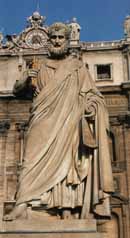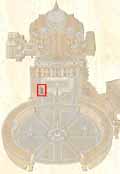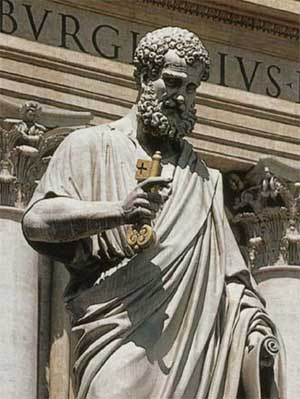| Grottoes
Vatican City Colonnade Saints Floorplan #2 |
| Altars
Monuments The History |
|
Related Items |
 |
From: Roma Sacra - San
Pietro in Vaticano, © 1995 Elio de Rosa
The replaced, older statues of Sts. Peter and Paul were the work of Paolo
di Mariano, called the Taccone, and his workshop (1461-1462), and are
currently in a room of the Library of Sixtus IV, in the Apostolic Palaces.
In 1849, the stonecutters, Angelo Bezzi, Fortunato Martinori and Vincenzo
Biancheri, completed the tall pedestals, decorating them with the heraldic
emblems of Pius IX and of the Reverend Fabbric of St. Peter, indicated
with the letters R.F.S.P. In the internal mirror of the base, there is
the inscription:
PONT. MAX. / PETRI APOSTOLORVM PRINCIPIS / SIGNVM / MAGNITVDINI TEMPLI
VAT. PAR / HEIC OPPORTVNO IN LOCO / STARE IVSSIT / ANNO MDCCCXLVII / SCARI
PRINCIPATVS EIVS I / LAVRENTIO LVCIDI CVR. OP. VAT.
(The Pontiff ordered the images themselves here, in a suitable place, equal to the size of the temple of Peter prince of the Apostles. In the year 1847, the first of his pontificate, while he was curator of the Vatican Works Lorenzo Lucidi)
From: Works on the Facade
of St. Peter's Basilica, Vatican Polyglot Press
The Old Statues
During the Pontificate of Pius II (Enea Silvio Piccolomini, 1458-1464)
the statues of Saints Peter and Paul were placed at the lower part of
the marble staircase at the entrance to the Constantinian Basilica.
Some authors, among them Bonanni, Torrigio and Mignanti, attribute the two statues to Mino da Fiesole; Vasari, however, believes that they were the work of Mino of Reame, while Muntz claims that they are by Paolo Romano. With the continuation of the Vatican Basilica, begun in 1502 and completed in 1612 with the construction of the imposing facade by Maderno (1556-1629), the statues were maintained in an analogous position, but brought further to the front of the new structure.
During the pontificate of Alexander VII (Fabio Chigi 1655-1629), the architect Gianlorenzo Bernini finished the work on St. Peter's Square, with his great sloping entrance to the threshold of the Vatican Basilica; in 1666 he had completed the famous colonnade after nine years of intense labor. Bernini himself adapted the two statues of Peter and Paul at the foot of the stairs, even though their dimensions were much smaller than the new architectural complex of the Basilica demanded.
The Current Statues
In 1849 Pope Pius IX (Giovanni Mastai Ferretti, 1846-1878) decided to
replace the above-mentioned statues with the larger ones that his predecessor,
Gregory XVI (Bartolomeo Alberto Cappellari, 1831-1846), had commissioned
for the Basilica of St. Paul's Outside-the-Walls. These statues had never
been placed there because they were judged to be unsuitable for the inside
of that Basilica.
The statue of St. Peter was sculpted from 1838-1840 by the Venetian sculptor Giuseppe De Fabris (b. Nove di Bassano 1790 - d. Rome 1860); the artist had studied in Milan, at the school of Gaetano Monti. At the age of twenty-three he entered the school of Canova in Rome; in 1836 he finished the funerary monument of Leo XII (Annibale della Genga 1823-1829) which is above the entrance to the Chapel of the Relics, between the Chapel of the Pieta and the Chapel of St. Sebastian, in the northern (right) nave of the Basilica.
The statue of St. Peter is iconographically faithful to the noteworthy pictures and sculptures of the sixteenth and seventeenth centuries; however, it especially expresses inspiration and sentiment, thereby showing the artist's reaction to the academic rigor of the era. In his right hand the apostle is holding the keys, symbol of the power promised to him by Christ in Caesarea of Philippi; in his left hand is the scroll bearing the words "ET TIBI DABO CLAVES REGNI CAELORUM' (Mt. 16, 19). One key is silver-plated, while the other is gold plated.


